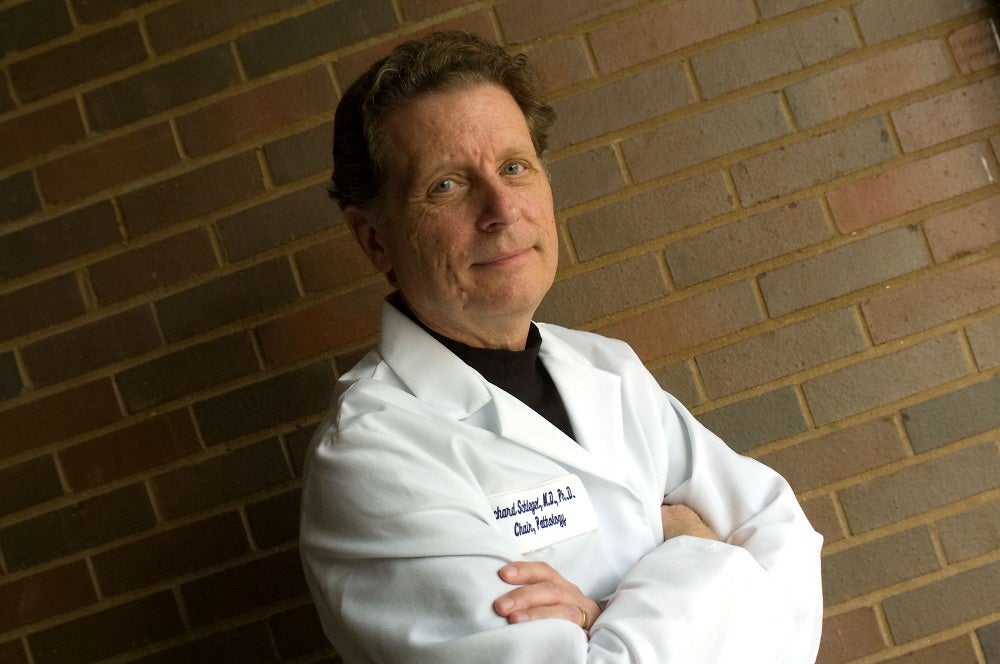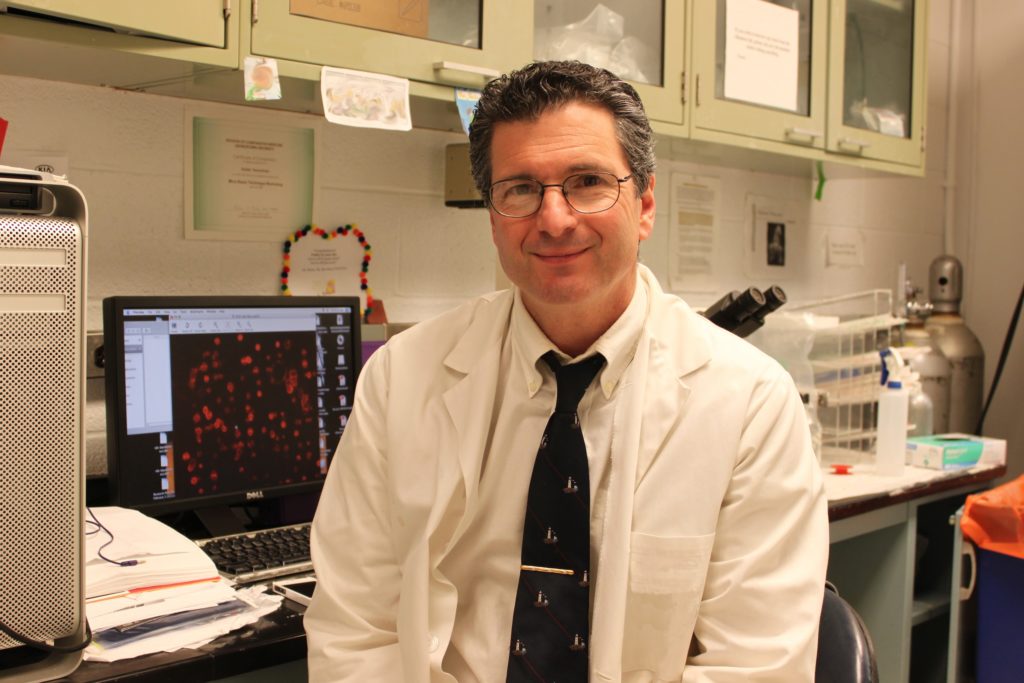New Center Serves as Research Hub
Posted in GUMC Stories | Tagged cancer, cancer research, Center for Cell Reprogramming, Georgetown method
(March 20, 2013) — It quickly became known as the “Georgetown method.” A revolutionary way of growing both tumor and normal cells in order to one day truly personalize therapy has drawn scientists from across the country, even internationally, to Georgetown University Medical Center (GUMC).
As of March, these visiting and collaborating researchers will meet with GUMC scientists under the rubric of the new Center for Cellular Reprogramming. The Center acts as a global center of excellence whose mission is to promote intra- and extramural collaborations, education and development, and is centered around the broad topic of the use of stem-like cells. Specific emphasis is placed on developing applications that will drive personalized medicine to a new level. Of course, the topic foremost on everyone’s mind is development of the “method” — formally known as conditionally reprogrammed cells (CRCs).
“We already have collaborators from around the world driving this technology forward,” says Richard Schlegel, MD, PhD, chairman of the department of pathology at GUMC and a professor of oncology at Georgetown Lombardi Comprehensive Cancer Center, a part of GUMC.
“The center is a great addition to the work we are doing with CRCs,” says Schlegel, who along with several colleagues at Georgetown and the National Cancer Institute invented the technique that produces immortal cell lines from individual patients. “No longer will scientists say they are coming to Georgetown to see Dick and Chip,” he adds with a laugh. “They are coming to the Center for Cellular Reprogramming and all that it can offer.”

Richard Schlegel, MD, PhD 
Chris Albanese, PhD
“Dick” is, of course, Schlegel, who is director of the center, and “Chip” is Chris Albanese, PhD, the center’s deputy director and director of experimental pathology at Georgetown Lombardi. The Schlegel and Albanese labs will act as the center’s hub, but its spokes already include 15 collaborators throughout Georgetown Lombardi and GUMC, and 10 from around the country — including investigators from Yale University School of Medicine, MD Anderson Cancer Center, Massachusetts General Hospital and the National Institutes of Health, among others.
Georgetown Lombardi investigators are using CRCs to pursue biology-based studies in prostate, breast cancer, thymoma, head and neck cancers, and they are being used to support two phase I clinical trials within the MedStar Georgetown Cancer Network. Researchers at Yale, the University of North Carolina and Memorial Sloan Kettering Cancer Center are also investigating the utility of CRCs in a variety of diseases. The National Cancer Institute is using CRCs in studies of head, neck and genitourinary cancers.
When these researchers visit the center, Schlegel and Albanese ask them to speak to students — undergraduates as well as medical and nursing school students. “This is a great opportunity to educate and excite the next generation of researchers,” Schlegel says. Georgetown has a patent pending on the method, but it can be used freely by scientific investigators.
“This new technology could provide a transformational, dynamic platform for personalized cancer therapy,” says Louis M. Weiner, MD, director of Georgetown Lombardi. “Others share our view,” he adds, referring to Doug Melton, PhD, co-director of the Harvard Stem Cell Institute. In a 2012 news story about Schlegel’s cell reprogramming approach, Melton told the Associated Press, “What could be more personalized than taking this person’s cell, growing it in culture, finding a drug to treat them and then treat them?” Melton added that the Georgetown method “gives an answer quickly enough that it could save lives.”
‘A better, faster, cheaper approach to personalized medicine’
Before Schlegel’s breakthrough in December 2011, no one had been able to keep both normal cells and cancer cells alive indefinitely in a laboratory. Immortalized tumor cell lines did and still do exist, but they have changed so much over the decades that researchers say they do not resemble natural cancer cells any more.
Schlegel, along with his colleague Xuefeng Liu, MD, discovered that adding two different substances (a Rho kinase inhibitor and fibroblast feeder cells) to cancer cells or to normal cells pushes them to morph into stem-like cells that stay alive indefinitely. When the two substances are withdrawn from the cells, they revert back to the type of cell they once were. They dubbed these cells conditionally reprogrammed cells.
The advance was seen as an exciting demonstration of personalized cancer medicine. In fact, a case study authored by Schlegel and his team, reported in 2012 in the New England Journal of Medicine, demonstrated how CRCs derived from normal and tumor cells of a 24-year-old man with a rare type of tumor allowed physicians to identify an effective therapy. These cells were used to screen potential treatments and in this way, the scientists were able to see which therapies were active against the tumor cells and less harmful to the normal cells.
“Our first clinical application utilizing this technique represents a powerful example of individualized medicine,” Schlegel said at the time. But he cautioned, “It will take an army of researchers and solid science to figure out if this technique will be the advance we need to usher in a new era of personalized medicine.”
That army is now mobilizing — and they are knocking at Georgetown’s doors.
“CRCs really could offer a fundamental change in the way drug treatments are selected for each individual patient,” says Albanese.
Schlegel likens the potential use of CRCs to a throat swab test for a bacterial infection. “Cells from the swab are tested against several different antibiotic treatments, and the one that kills the bacteria is the agent a patient is treated with,” he says. “The analogy is this: say a woman has breast cancer, and a biopsy is taken. Using CRCs, we can grow cells from her tumor in the laboratory, and quickly test hundreds of anticancer drugs to see which one kills the cells,” Schlegel says. “We would also take a few noncancerous cells from her, grow them, and test the therapies to see if any of the drugs are too toxic.
“Potentially, we can also test tumors that have recurred in a patient to see if they will respond a second time to identical therapy, or to find a new treatment that will work. This could all be done quickly — an answer may be possible within two or three weeks,” Schlegel adds.
“Because we can repeatedly sample for drug sensitivity, even if the patient has a relapse of their cancer, we anticipate that our system will be a major advance in our fight to make cancer a highly manageable disease and compared to anything available now, this is the better, faster, cheaper approach to personalized medicine,” Albanese says.
Of course, much work needs to be done before the Georgetown method can be approved for this use by the U.S. Food and Drug Administration, he adds. “But with so many researchers excited about the potential of CRCs, validation should come soon.”
Georgetown University has filed a patent application on the technology described in this paper. Schlegel and Liu are inventors on the patent. The research described here was funded by a grant to Schlegel from the National Institutes of Health (R01 OD011168), a Department of Defense Prostate Synergistic Idea Development award and an RO1 National Cancer Institute grant (CA129003) to Albanese.
By Renee Twombly, GUMC Communications
